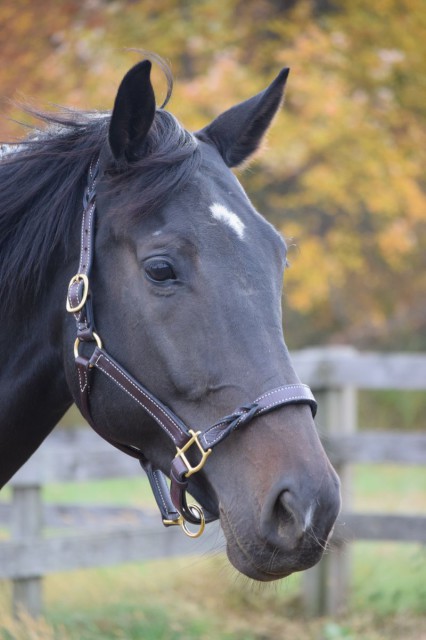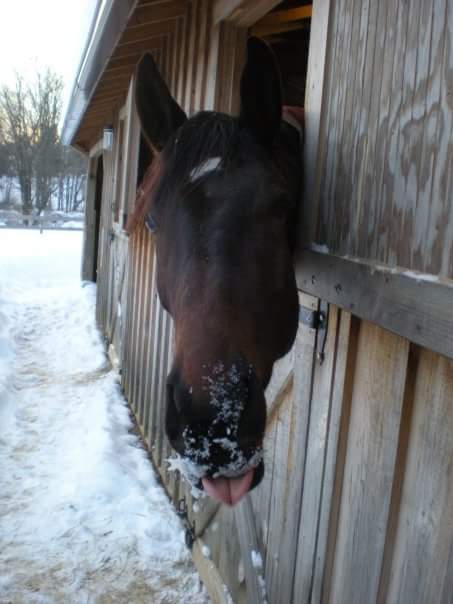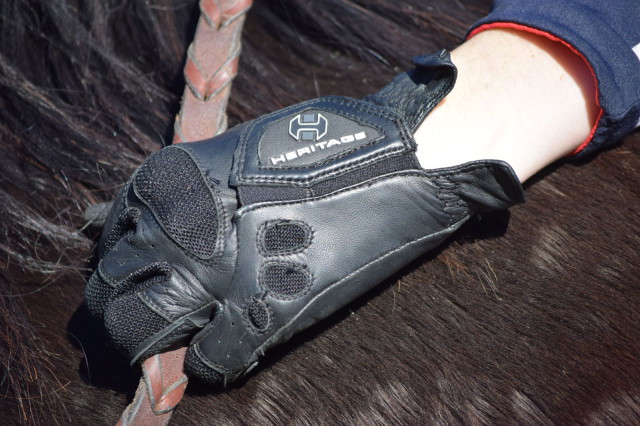Welcome to EN’s Product Review series! Who doesn’t love shopping, especially when the object of your search is new gear for yourself or your horse? As an enthusiast of all products equine, I LOVE trying out new gear. Please join me as I narrate my personal journey of trying out all of the products featured. While I will make no recommendations, I hope you have fun reading about my many adventures of trying new products, and that hearing about my personal experiences helps you on your own quest for new gear. Go Shopping.
 The back pockets feature a detailed sequin and embroidered design on them that look like a firey bird design...I always like to think of the design as the flaming wings of a phoenix (can you tell that I'm a Harry Potter fan?). Photo by Lorraine Peachey
The back pockets feature a detailed sequin and embroidered design on them that look like a firey bird design...I always like to think of the design as the flaming wings of a phoenix (can you tell that I'm a Harry Potter fan?). Photo by Lorraine Peachey
I tend to gravitate towards that which has an extra bit of sparkle, shine, or glam. It’s not that I’m a girly girl or anything…on the contrary, I’m a throw on my muck boots and head right through a muddy paddock kind of girl. And I don’t mind it one bit.
But that’s just one facet of who I am. I also like cleaning up after mucking it around the barn. Because I’m not a fan of going out when I’m fresh from barn chores…hay in my hair, horse slobber on my face and mud on my jeans. Even if I’m only visiting the feed store.
My style? It’s something that changes with my mood, and can range anywhere from whimsical bohoesque to country girl chic. But there is usual a dash of equestrian flair thrown into the mix somewhere. Along with something to add a bit of glam to everyday life.
Incorporating a little sparkle or shine into everyday life makes things a little more interesting. Just ask my saddle. My lovely close contact saddle that is made out of soft, grippy leather, has a shock absorbing seat, AND…a fancy silver plate decorating the cantle.

The Huntley breeches feature a 2″ wide waistband with a modified mid rise styling, which is complimented by wide belt loops. Photo by Lorraine Peachey.
So we’ve established…I’ve an affinity towards everyday usefulness. Especially when it is glammed up a bit to make life interesting. Which is why my eye was caught by a pair of black full seat breeches from Huntley Equestrian.
These are not your everyday black pair of breeches though…oh no. For these particular pair of breeches also feature a sequin design on their back pockets. Hello, blingy elegance! It is true that the tasteful bling is what initially drew me towards Huntley Equestrian breeches.
Before I get too excited about bling, let’s take a step back to focus on the breeches themselves. The breeches are crafted out of a cotton, nylon and spandex blend fabric, which is both smooth and stretchy feeling.
They feature a 2″ wide waistband with a modified mid rise styling, which is complimented by wide belt loops. Two side pockets incorporated into the design. And, they also include a zip front, with a double button closure…with buttons that feature the Huntley Equestrian logo.

There was no need to fret (about my saddle), as the sequin design is intentionally set higher up, so that it did not come into contact with my saddle while I rode. Photo by Lorraine Peachey
Taking a closer look at function, the full seat of the breeches is constructed out of a Daewoo suede, which feels nice to the touch. The bottom of each of the legs also features an integrated sock design, in order to provide comfort under tall boots or half chaps.
But the details are where I really get caught up. The back pockets feature a detailed sequin and embroidered design on them that look like a firey bird design…I always like to think of the design as the flaming wings of a phoenix (can you tell that I’m a Harry Potter fan?).
The back pockets are also shaped to accent the full seat design of the breeches. Plus, I also like that the pockets also feature a red colored zipper. In this was, it adds a nice styling accent, and is functional at the same time.
And I can’t forget to mention the stitching of the breeches. While the breeches are black , the yellow and orange colored stitching contrasts oh so very nicely against it. Plus, it also matches the sequin “fire bird” design on the rear pockets, which ties the design together nicely.

While the breeches are black , the yellow and orange colored stitching contrasts oh so very nicely against it. Plus, it also matches the sequin “fire bird” design on the rear pockets, which ties the design together nicely. Photo by Lorraine Peachey.
When I pulled on the pair of black full seat breeches from Huntley for the first time, I was very happy with the way they fit. The fit and fabric were able to accommodate my curves nicely. I wore my usual size, and also found the stretch of the fabric to be comfortable.
And I continue to be pleased with the way that the breeches look, each and every time that I pull them on. The sequin design, along with the matching contrast stitching offer quite a fabulous look. Which leaves me feeling totally glam in the saddle.
Speaking of the saddle…a point of concern for me was whether or not the sequin design would rub against my saddle. There was no need to fret, as the sequin design is intentionally set higher up, so that it did not come into contact with my saddle while I rode.
I found that the stretch of the fabric helped the Huntley breeches to feel comfortable while riding. Plus, I found that the Daewood suede full seat provided me with a good grip on the saddle during my rides.
The Black Full Seat “Fire Bird Glam” Breeches (ok, I made the last part up) from Huntley Equestrian are available in sizes 24 through 34. This style of breeches retails for $179.99, and you can find them here.
The full range of Huntley Equestrian breeches, which retail starting at $109.99, and you can see the entire range here.
Go Breeches…with Bling. Go Huntley Equestrian. Go Eventing.
































































